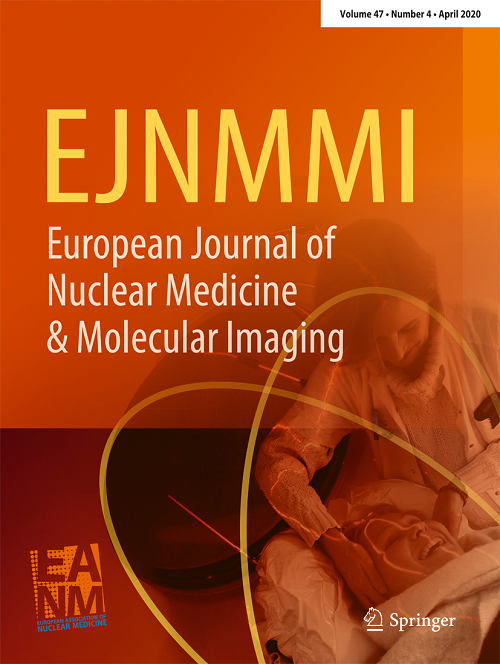[18F]治疗后12周氟脱氧葡萄糖正电子发射断层扫描/计算机断层扫描和液体活检监测局部区域进展性鼻咽癌。
IF 7.6
1区 医学
Q1 RADIOLOGY, NUCLEAR MEDICINE & MEDICAL IMAGING
European Journal of Nuclear Medicine and Molecular Imaging
Pub Date : 2025-10-01
DOI:10.1007/s00259-025-07529-z
引用次数: 0
摘要
目的在鼻咽癌(NPC)中,放疗后12周是发现残留疾病和远处转移的关键监测窗口期。我们的目标是评估rt后12周PET/CT和cfEBV DNA水平在局部区域晚期鼻咽癌(LA-NPC)监测中的作用。方法纳入III-IVa期LA-NPC患者。在治疗前和治疗后12周进行PET/CT扫描。在治疗前、放疗后4周、12周和24周以及随后每隔3至6个月对cfEBV DNA进行评估。主要终点是12周PET/CT阴性预测值(NPV),用于识别局部残留疾病(RD)和/或远处转移(DM)。结果2018年至2021年期间,506名符合条件的患者前瞻性入组(中位随访时间:45.2个月)。在放疗后12周,22例患者(4.3%)确诊为RD, 30例患者(5.9%)确诊为DM, 6例患者(1.2%)同时确诊为RD和DM。对于整体RD和/或DM, 12周PET/CT显示NPV为96.3%,敏感性为72.4%,特异性为93.3%,阳性预测值(PPV)为58.3%,准确性为90.9%。12周cfEBV DNA的相应值为NPV为91.7%,敏感性为41.7%,特异性为34.5%,PPV为93.8%,准确性为87.0%。在以12周cfEBV DNA水平定义的亚组中,未检测到cfEBV DNA的患者PET/CT的NPV为96.8%,而可检测到cfEBV DNA的患者PET/CT的敏感性为85.0%。结论rt后12周进行pet /CT是LA-NPC监测的可靠工具,有助于优化随访策略,及时进行治疗干预。PET/CT和cfEBV DNA的联合使用为有效管理患者提供了有价值的风险分层见解。本文章由计算机程序翻译,如有差异,请以英文原文为准。
[18F] Fluorodeoxyglucose positron emission tomography/computed tomography scan and liquid biopsy at 12 weeks posttreatment for surveillance of locoregionally advanced nasopharyngeal carcinoma.
PURPOSE
In nasopharyngeal carcinoma (NPC), the 12-week period following radiotherapy (RT) represents a critical surveillance window for detecting residual disease and distant metastasis. We aim to assess the role of PET/CT And cfEBV DNA levels at 12 weeks post-RT in the surveillance of locoregionally advanced nasopharyngeal carcinoma (LA-NPC).
METHODS
Patients with stage III-IVa LA-NPC were included. PET/CT scans were conducted both pre-treatment And at 12 weeks post-RT. cfEBV DNA was assessed pre-treatment, at 4, 12, And 24 weeks post-RT, And subsequently at 3- to 6-month intervals. The primary endpoint was the negative predictive value (NPV) of 12-week PET/CT for identifying locoregional residual disease (RD) and/or distant metastasis (DM).
RESULTS
Between 2018 And 2021, 506 eligible patients were prospectively enrolled (median follow-up: 45.2 months). At 12 weeks post-RT, RD was identified in 22 patients (4.3%), DM in 30 patients (5.9%), And both RD And DM in 6 patients (1.2%). For overall RD and/or DM, 12-week PET/CT demonstrated An NPV of 96.3%, sensitivity of 72.4%, specificity of 93.3%, positive predictive value (PPV) of 58.3%, And accuracy of 90.9%. The corresponding values for 12-week cfEBV DNA were An NPV of 91.7%, sensitivity of 41.7%, specificity of 34.5%, PPV of 93.8%, And accuracy of 87.0%. Among subgroups defined by 12-week cfEBV DNA levels, patients with undetectable cfEBV DNA showed a 96.8% NPV for PET/CT, whereas those with detectable cfEBV DNA demonstrated an 85.0% sensitivity for PET/CT.
CONCLUSION
PET/CT performed at 12 weeks post-RT is a reliable tool for surveillance in LA-NPC, facilitating the optimization of follow-up strategies and enabling timely therapeutic interventions. The combined use of PET/CT and cfEBV DNA provides valuable risk-stratified insights for managing patients effectively.
求助全文
通过发布文献求助,成功后即可免费获取论文全文。
去求助
来源期刊
CiteScore
15.60
自引率
9.90%
发文量
392
审稿时长
3 months
期刊介绍:
The European Journal of Nuclear Medicine and Molecular Imaging serves as a platform for the exchange of clinical and scientific information within nuclear medicine and related professions. It welcomes international submissions from professionals involved in the functional, metabolic, and molecular investigation of diseases. The journal's coverage spans physics, dosimetry, radiation biology, radiochemistry, and pharmacy, providing high-quality peer review by experts in the field. Known for highly cited and downloaded articles, it ensures global visibility for research work and is part of the EJNMMI journal family.

 求助内容:
求助内容: 应助结果提醒方式:
应助结果提醒方式:


